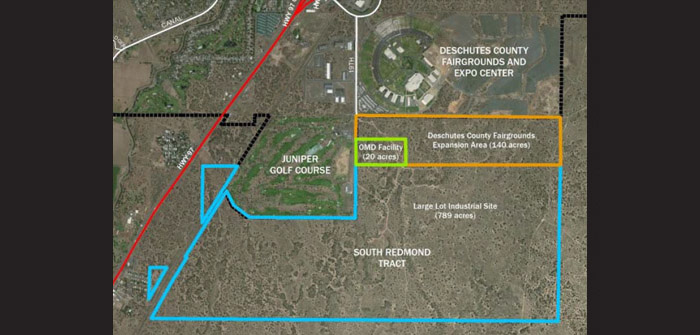(Map | courtesy of City of Redmond)
Stage Set for State’s 4th-Largest Industrially-Zoned Contiguous Parcel
Redmond is paving the way for potential large-scale industrial development on a 949-acre tract south of the Deschutes County Fair & Expo Center which will represent one of the top available inventories of its type in the state, thanks to a decade-long collaborative effort featuring multiple regional agencies.
A major milestone was reached earlier this month as the Redmond City Council and the Deschutes County Board of Commissioners took concurrent actions setting the stage for development of the sprawling site.
The passage of the ordinances brings the subject acreage inside the Redmond Urban Growth Boundary (UGB) and the associated Master Development Plan approvals set out the vision for future development.
A total of 140 of the 949 acres will be dedicated to an expansion of the Deschutes County Fairgrounds, while a 20-acre parcel has been set aside for the Oregon Military Department (OMD). The remaining 789 acres is reserved for industrially-zoned parcels ranging from 50 to 200-acre sites.
“It’s now time to roll up our sleeves and work with Redmond Economic Development Inc. (REDI) and Economic Development for Central Oregon (EDCO) to bring family-wage industrial jobs to Redmond,” said Redmond Mayor George Endicott.
The authorizations concluded more than ten years of collaboration across multiple agencies including the City, Deschutes County, Central Oregon Intergovernmental Council (COIC), the Department of State Lands (DSL), EDCO, Department of Transportation (DOT), Oregon Military Department (OMD), Regional Solutions, REDI and others.
The approvals will now take a prescribed path as the property moves to a target of being shovel ready in 2020. The Department of Land Conservation and Development (DLCD) will review for concurrence before formal annexation of the property into the City limits, and DSL — which has an ownership position — will make infrastructure investments into what is now raw land in preparation for development readiness.
The latest milestone is the culmination of a multi-pronged effort that began over ten years ago. In 2008, Bev Thacker, Industrial Lands Specialist with the Oregon Economic and Community Development Department (now Business Oregon) stated in a letter, “Large, ready to go industrial sites have been the state’s most significant development challenge and one of the most noticeable changes in real estate trends in [the]last few years.”
She specifically identified a statewide need of industrial lands of 100-200 acres in size.
EDCO identified similar challenges for the tri-county (Deschutes, Jefferson and Crook) region and Executive Director Roger Lee and others have repeatedly stated that site selectors often will not even visit the region if only one or two sites are available.
The arrival of Facebook and Apple in Prineville, while unique in many regards, has put Central Oregon on the international map for data centers among other potential large lot employers. However, the region lacks a supply of sites and cities’ traditional Economic Opportunity Analyses did not account for such a land demand.
Deschutes County received two Technical Assistance Grants from the Department of Land Conservation and Development (DLCD) in 2010 to evaluate Central Oregon’s opportunities, competitiveness, and ability to recruit new and locally grown firms requiring new large-scale development models, and thereafter commissioned a Regional Economic Opportunity Analysis (REOA) study.
The REOA project, in which EDCO took a leadership position, aimed to determine if such a land demand existed in Central Oregon and, if so, to identify the deficiency. The study concluded that there was an unmet twenty-year land need for large lot industrial sites in the region.
It also concluded that competing as a cohesive region would allow Central Oregon to market a larger available work force, the size of which is often a key locational criterion for firms.
While geographically separate, the study concluded that the jurisdictions in the region can function in a manner similar to other metropolitan areas like Reno and Salt Lake City. According to the REOA, the shared economic function within Central Oregon supports a regional approach to economic development, particularly with respect to large traded sector industries.
The City of Redmond rose to prominence as a candidate as it serves as a major hub of the region, and the commercial airport provides a key advantage. The community has historically seen land prices somewhat below Bend and is well situated to serve the region due to its central location. The area has some small and medium sized industrial sites, and the range of commercial services trails only Bend in the region.
REDI Senior Director Jon Stark, who has been involved in the process since its early days, said the property could be market-ready within as soon as 18 months, once the masterplan is concluded, annexation complete and infrastructure installed.
He added, “Once this is up and running, we will have among the top large lot industrial opportunities in the state, with a total land inventory of over 2,000 acres catering primarily to medium to large sites.
“Our area does well in sectors like distribution facilities, biomedicine, aerospace and advanced manufacturing, and the upcoming larger lot inventory will give companies an opportunity to not have to locate to the congested I-5 corridor, while still having access to major markets like Portland and Seattle.”
Proceeds from the sales of lots within the 949-acre boundary will go to benefit the Common School Fund, which, since Oregon became a state in 1859, has provided hundreds of millions of dollars for public schools.
The little-known fund’s distributions are considered local revenue in the state funding formula, and the dollars are not insignificant. In a district such as Corvallis, their 2018 share of $979,238 supported the equivalent of 11 full-time teaching positions; in Bend 20; and in Medford 15.5.
Last year, the distribution was approximately $100 per student, with $57.63 million earmarked for the state’s 197 K-12 Districts.





